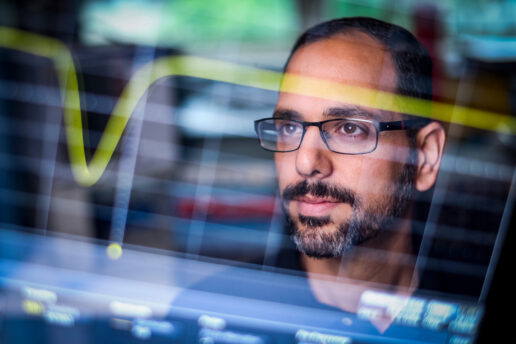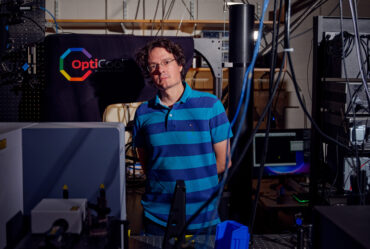
Or Hen: Getting to the core of the matter
To understand how everything from atoms to neutron stars behave, he says, requires “abstracting away the details to see main principles that drive everything.”
Every now and then, Or Hen, who recently received tenure as an associate professor of physics at MIT, will refer back to a file that he has kept since middle school.
The file is a comprehensive assessment of Hen’s learning disabilities, stemming from dysgraphia — a neurological condition in which someone has difficulty translating their thoughts into written form. Hen was diagnosed with a severe case of dysgraphia as a kindergartener. In middle school, due to an administrative snafu, the school was unaware of his condition and, lacking proper support, Hen failed most of his classes. It wasn’t until one teacher took a special interest that Hen was sent for a detailed assessment of his learning abilities.
That assessment, which Hen did not read until later, when he was well into his undergraduate degree in physics, was for him a revelation and validation.
“I saw a lot of ‘he’s bad at this, and not good at that,’ and it went through all the things I failed at,” Hen recalls. “But there was one test where I did extremely well, and which they had bold-faced.”
It was a test of nonverbal thinking, or abstract comprehension, assessing Hen’s ability to conceptually pare down complex ideas to their fundamental core. In this test, Hen scored in the 99th percentile. Fittingly, by the time Hen read this, he was already immersed in studies of abstract concepts and systems in nuclear physics. On his own, he had gravitated to a field that suited his strengths. Reading the assessment gave him confidence in his own instincts.
“They wrote that ‘this skill is particularly strong in him, and you should push him toward areas that utilize it,’” Hen says.
He brings this up to students at MIT today, not to brag, but as a guide.
“I try to emphasize that there is more than one path to success,” Hen says. “Try to think about what you’re good at, and then do the hard work of finding out what area, group, subfield, can utilize that. Find the thing you bring that’s unique, and build on that. Because then you really shine.”
Today, Hen and his research group are probing the inner workings of the nucleus, the interactions between protons and neutrons, and their even smaller constituents of quarks and gluons, which are the basic ingredients that hold together all the visible matter in the universe. Hen seeks connections between how these particles behave and how their interactions shape the visible universe and extreme astrophysical phenomena such as neutron stars.
“A lot of physics, in my mind, is taking complex systems with lots of details and abstracting away the details to seek the main principles that drive everything,” he says.
A frontier of ideas
Hen grew up in the countryside of Jerusalem, Israel, as part of a moshav — a small Jewish village, where his family worked as farmers, raising chickens for their eggs. In kindergarten, once Hen was diagnosed with dysgraphia, his parents sought out any available resources to help him with his writing.
“I think my mother’s entire salary went toward corrective lessons,” Hen recalls.
In middle school, once the records of his condition were transferred to the school, and an assessment was made of his abilities, Hen was given permission to take his exams orally. Rather than writing his answers, he would sit with a teacher and talk it out. To this day, he credits his loquacious nature to those early, formative years.
“Everyone who knows me knows I talk a lot,” Hen says. “And part of that was the way I was able to learn by talking about the material.”
Once he could work around his dysgraphia, however, Hen soon became bored by the content of his lessons, and in high school, he routinely skipped class. A teacher, seeing his potential, told his parents about an outreach program at the nearby Hebrew University, which Hen’s teacher thought might challenge the boy in ways that high school could not.
In his last two years of high school, Hen took part in the program and enrolled in a couple university classes in programming, which he quickly took to. After graduation, he attended Hebrew University full-time, double-majoring in computer engineering and physics — a topic that he thought he might like, as his older brother had also majored in the topic.
One class, early on in his first year, was especially motivating. The class explored ideas in modern physics, and students got to hear from different physicists about the concepts and phenomena they were tackling in the moment.
“It showed us that the beginning of our studies may be hard and annoying, but this is what you’re working toward,” Hen says. “In that class, we learned about quantum mechanics and nonlinear solids and astrophysics, and it just gave us a view of the frontier of the field.”
At the core
After completing his undergraduate degrees, Hen joined the Israeli Defense Forces, which is a mandatory service for all Israeli citizens. He spent seven years in the army, working as a researcher in a physics laboratory.
In tandem with his military service, Hen was also pursuing a PhD in physics, and would make the short trip to Tel-Aviv University once a week and on weekends to work on his degree. There, he got to know an eccentric and beloved professor who took a chance on Hen and offered him a rare opportunity: to travel to the United States to help build a new particle detector. The detector would be based at Jefferson Laboratory, a facility funded by the U.S. Department of Energy that houses a huge particle accelerator, designed to collide beams of electrons with various atomic nuclei.
With a particle detector, physicists could essentially snap pictures of a collision and its aftermath, to tease out the subatomic constituents and their properties, and how they interact to make up an atom’s nuclear structure.
Hen spent a summer at the facility, helping to build a neutron detector that physicists hoped would shed light on “short-range correlations” — extremely brief, quantum-mechanical fluctuations that can occur between some protons and neutrons within an atom’s nucleus. When these particles get so close as to touch each other, their interactions become stronger, though only for a moment before they flit away. It’s thought that these short-range correlations are the source of most of the kinetic energy in a nucleus, which itself is the basis of all visible matter in the universe.
“More than half the kinetic energy in a nucleus comes from these weird states,” Hen says. “If you ever want to understand atomic nuclei and visible matter at its core, you have to also understand short-range correlations.”
Helping to build the neutron detector was a gratifying combination of hands-on work and abstract thinking, and from then on, Hen was hooked on experimental nuclear physics.
After completing his PhD, and a thesis on short-range correlations, Hen headed to MIT, where he interviewed for a postdoc position as a Pappalardo Fellow in the Laboratory of Nuclear Science. As he chatted with one person after another, he eventually found himself in the office of then-department head Peter Fisher, who encouraged Hen to also apply for an open faculty position.
A few months later, in 2015, he found himself in the fortunate position of starting at MIT as a postdoc, having already accepted a junior faculty position he would start at MIT 18 months later.
“MIT took a bet on me,” he says. “That’s the unique thing about MIT. They saw something in me that I didn’t see back then, and they supported me.”
Particle connections
In his first years on campus, Hen continued his work in short-range correlations. His group used data from particle accelerators around the world to develop a universal understanding of short-range correlations in a way that can be applied across many scales. It could, for instance, predict how the interactions would determine correlations in one type of atom versus another, and shape the behavior of much more dense and extreme phenomena such as neutron stars.
Hen also expanded into the field of neutrinos, which are nearly massless particles that are the most abundant particles in the universe. The properties of neutrinos are thought to be the key to the origins of matter, though neutrinos are notoriously difficult to study in detail because their detection requires detailed understanding of their interaction with atomic nuclei. Hen found that, instead of depending on the elusive interactions of neutrinos, there might be a way to abstract that behavior to that of a more detectable particle, to better understand the neutrino itself.
By analyzing data from electron-beam accelerators around the world, his group founded the “electrons-for-neutrinos” effort, which developed a framework that essentially transposed the interactions of an electron to describe how a neutrino would behave under similar circumstances — a tool that will help physicists interpret data from hard-to-pin-down neutrino experiments.
Reflecting on how he determines which direction to take his research, Hen says: “I have a big nose, and I like to talk to people and understand what they’re doing and whether can I do something there or not. I like to build communities, bring in people with different abilities, and do something big together, where the whole is greater than the sum of its parts.”
Big science
Hen got a chance to start up a big-science collaboration, as part of the Electron-Ion Collider (EIC), a concept for a particle accelerator that collides electrons with protons, neutrons, and nuclei to study the particles’ internal structures and how they are held together by the “strong nuclear force,” which is known as the strongest force in nature.
In late 2019, the EIC was a focus of a meeting at MIT, in which physicists from around the world gathered to discuss the project’s recent go-ahead, granted by the U.S. Department of Energy (DoE). The next step was to design a detector, and multiple versions were considered. Hen, who stopped in out of curiosity, wound up joining a community-wide effort to develop a menu of possible detectors that could be built at the EIC.
Hen then took a leadership role in the next step to put forward a specific detector design for the DoE to fund. Working closely with physicists Tanja Horn and John Lajoie, they called experts to join the effort, eventually gathering physicists from 98 institutions. Thanks to their collaborative efforts the DoE ultimately chose their design over a competing one. Hen and his colleagues subsequently reached out to that other group to join forces to further evolve and fine-tune the design.
“We combined strengths,” Hen says. “We are doing big science. And when you do big science, there’s lots of talented people involved. I’ve learned through this process that it’s all about how you interact with people and adapt yourself to do science, together.”
Today, Hen is overseeing aspects of the EIC’s science community that is leading its development, which is projected to break ground in the next few years. In the meantime, he continues to expand projects in his research group, and works to mentor his students and postdocs, just as he was supported through his early career.
“I’m a very fortunate person, in that I had so many mentors in my life, and they all believed in me and saw things I didn’t,” Hen says. “They noticed that I’m different in whichever capacity, and tried to squeeze that lemon. That was a big thing for me.”


